Situated atop a mountain that rises to 8,000 feet, Binsar Wildlife Sanctuary is a protected area that includes pine, rhododendron, and oak forests. It is located in Uttarakhand’s Kumaon, 30 kilometres northeast of Almora. It offers a wide variety of animals and birds, captivating vistas of the snow-capped Himalayas, lush jungles that resound with the sounds of streams and beautiful chirping, and meandering paths that lead to uncharted experiences! In Uttarakhand, Binsar Sanctuary is the ideal location for photography and birdwatching.
Location
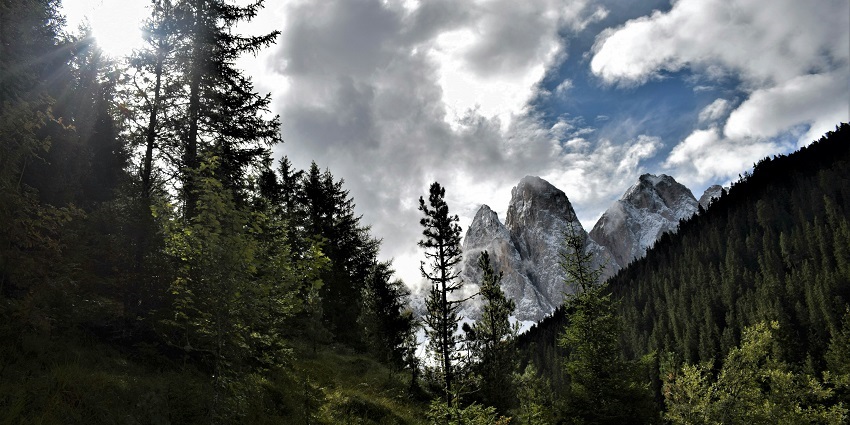
Photo: Camilla De Bernardinis / Wikimedia Commons / Image For Representation Only
In Uttarakhand, the town of Almara is roughly 30 kilometres from Binsar Wildlife Sanctuary. This sanctuary, which was created in 1988, is situated between 900 and 2,500 meters above sea level and spans an area of around 45 square kilometres. The sanctuary is renowned for its expansive views of the Himalayan range, abundant wildlife, and lush woods. In contrast to the more well-known national parks, Binsar provides a peaceful haven in the middle of the Himalayas where you can take in the splendour of verdant forests, a variety of species, and breathtaking views of the snow-capped peaks.
Suggested Read: Luxury Camping In Rishikesh
How To Reach
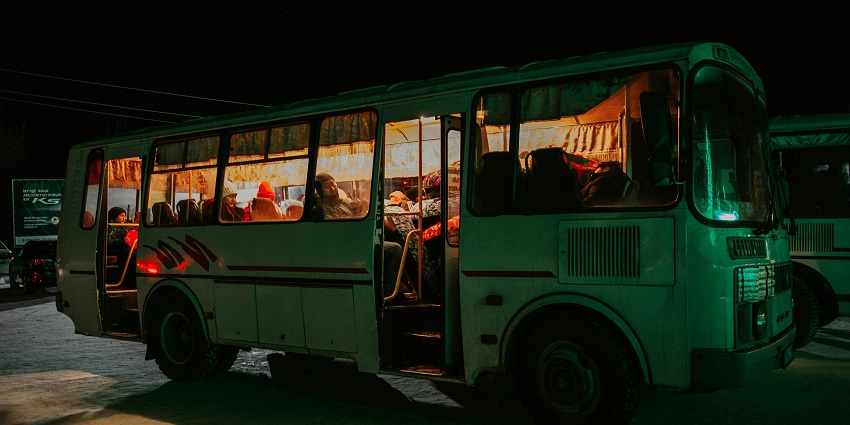
Photo: Sultan Raimosan / Pexels / Image For Representation Only
By Air: Pantnagar Airport, which is 152 kilometres from the city centre, is the closest airport to Binsar. Regular flights connect it to major Indian towns, including Delhi. To get to Binsar Wildlife Sanctuary from the airport, it’s simple to take the state-run buses or rent a taxi.
By Rail: The closest train station to Binsar is Kathgodam Railway Station, which is 119 kilometres from the city centre. There are two trains that run daily between Delhi and Kathgodam, and the station has good connections to places like Delhi, Lucknow, and Kolkata. One can take the state-run buses to Binsar Wildlife Sanctuary or book a taxi from the station.
By Road: Well-maintained motorable roads connect Binsar to northern Indian cities and significant towns in Uttarakhand. In the Kumaon area, you can also use shared and private taxis to move around Binsar. There are also plenty of state-run buses in the area that can transport you to and from the Binsar Sanctuary and throughout the city at reasonable prices.
Places To Visit In And Around Binsar Wildlife Sanctuary
Although the main draw is the Binsar Wildlife Sanctuary, there are a number of other adjacent locations that are well worth seeing. The following are some of the best places to go in the sanctuary:
1. Binsar Zero Point
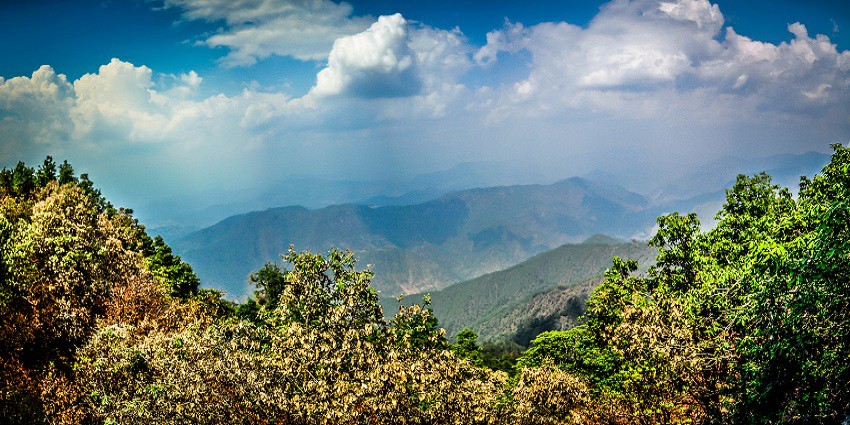
Photo: Kshitijjjj / Wikimedia Commons
The sanctuary’s highest point, Binsar Zero Point, provides sweeping vistas of the Himalayan range, as was previously described. Peaks like Nanda Devi, Trishul, and Kedarnath are visible on a clear day. The hike to Zero Point takes two to three hours and is comparatively simple. During a trip to Binsar Wildlife Sanctuary, Binsar Zero Point is a must-visit location for adventure seekers. The entrance fee for each candidate remains valid for up to three-consecutive days of the week.
Entry Fee: ₹150 per person
Timings: 9 AM – 5:30 PM
Suggested Read: Scenic Spots For Camping In Dhanaulti For A Mountain Retreat
2. Kasar Devi Temple
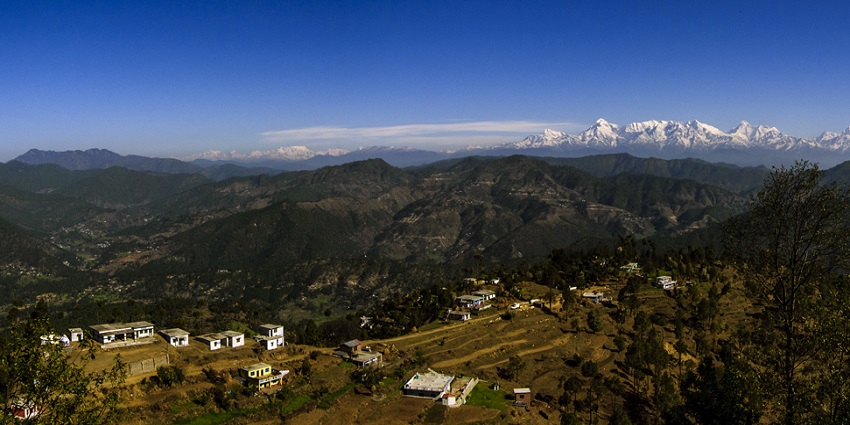
Photo: Michael Scalet / Wikimedia Commons
The little but important Kasar Devi Temple is devoted to the Hindu deity Kasar Devi and is only a short drive from Binsar Wildlife Sanctuary. The temple is well-known for its tranquil atmosphere and breathtaking views of the neighbouring valleys. Known for its spiritual atmosphere, the vicinity of the temple has drawn many well-known figures throughout the years, such as Bob Dylan and Swami Vivekananda.
Timings: 7 AM to 7 PM
3. Katarmal Surya Temple
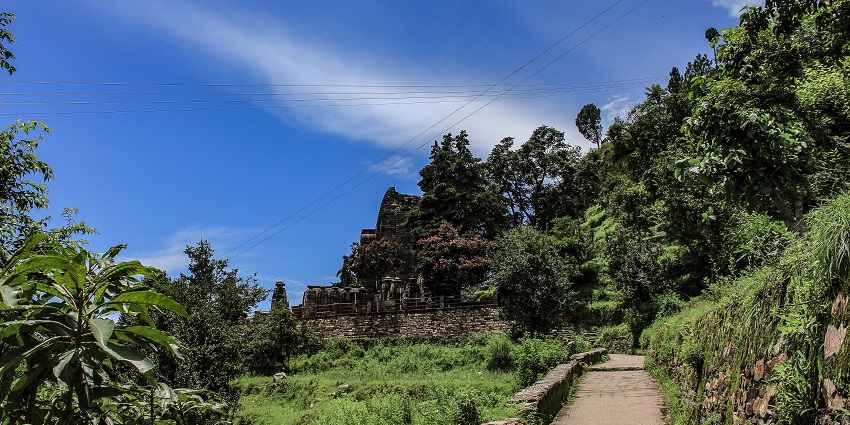
Photo: rrdarvesh / Wikimedia Commons
Built in the ninth century by Katarmalla, a Katyuri king, the Katarmal Surya Temple demonstrates the architectural style of the ancient craftsmen. This Hindu temple is located 19 kilometres from Almora and is 2,116 meters above sea level. Another name for this Surya Mandir (Sun Temple) is Badaditya (Baraditya) Temple. With its elaborate carvings on its wooden doors and panels, this temple was long regarded as India’s second most beautiful shrine, behind the Konark Sun Temple.
Entry Fee: Free entry
Distance: 19.2 km (from Almora)
Suggested Read: Explore The Best Camping In Mussoorie
4. Jageshwar Dham
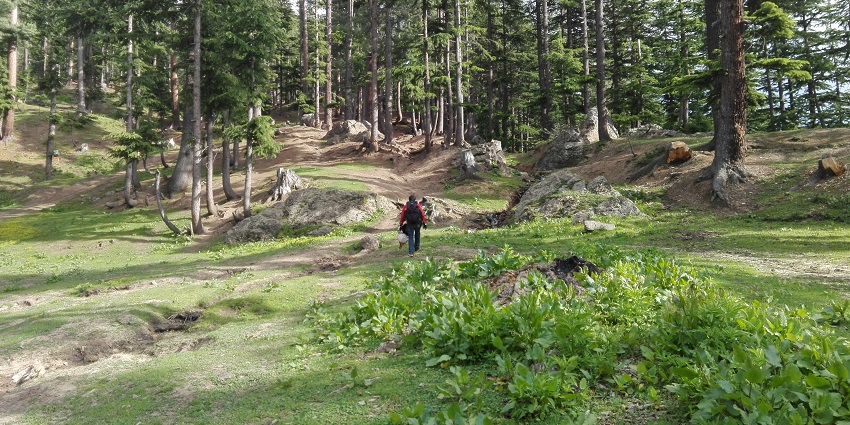
Photo: Jawadqada / Wikimedia Commons / Image For Representation Only
Jageshwar is located 37 kilometres from Almara and at an elevation of 1,870 meters above sea level. With thousands of visitors annually, Jageshwar is one of Kumaon’s most popular tourist destinations. It has a brook running through its backyard and is surrounded by a thick Deodar forest. Jageshwar was once a pilgrimage stop on the way to the well-known Kailash-Mansarovar pilgrimage many years ago. Today, Kathgodam is a well-liked off-the-beaten-path destination because it’s easily accessible from Delhi by train and only takes two to three hours to drive there, along with stunning Kumaoni villages and Deodar forests.
Activities: Camping, Yoga and Meditation
Best Time To Visit: January to December
5. Chitai Golu Devta Temple
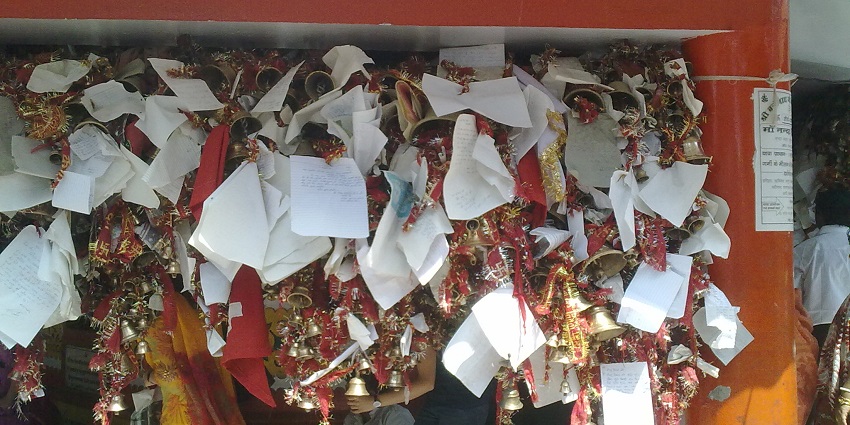
Photo: pramod nagher / Wikimedia Commons
Another fantastic destination for holidays is Chitai Golu Devta Temple. The temple, which honours Kumaon, is located around 4 km from Binsar Wildlife Sanctuary’s main gate. This temple is special because the deity is offered brass bells rather than candy. The devotees write their wishes on paper and affix it to the bells they donate. All in all, a pleasant, distinctive, and creative cultural encounter. There is a unique aura about the Chitai Golu Devta Temple. When viewed from a distance, it appears incredibly distinctive, particularly due to the various-sized bells that enthusiasts have tied here.
Distance: 4km (from Binsar Wildlife Sanctuary)
Best Time To Visit: November to April
Suggested Read: Uttarakhand Bungee Jumping
Where To Stay

Photo: Pixabay / Pexels / Image For Representation Only
Within the sanctuary are some estates, all of which have been transformed into lodgings. The Mary Budden Estate, with its stylish furnishings, fireplaces, and secluded areas, is a fantastic option if luxury is your top concern. The Tree of Life Grand Oak Manor, home of Sir Henry Ramsay, the previous Commissioner of Kumaon, offers a taste of Binsar’s colonial past. Enjoy breathtaking views of the valley and the Himalayas from this magnificent location, which is filled with old-world charm and vintage décor. Although the cuisine and service at the KMVN (Kumaon Mandal Vikas Nigam) guesthouse are mediocre, the great location more than makes up for the low price.
Where To Eat

Photo: Adi haque / Wikimedia Commons / Image For Representation Only
Binsar’s local food is a must-try when visiting. Aloo ke gutke, Madve ki roti (ragi roti), Bhatt ki daal, Bhaang ki khatai, Palak ka kapa, Kaudh ke daal, and Kumaoni raita are a few of the well-liked meals. Typically, a variety of regional ingredients, including pulses, herbs, and unique spices, are used to make these dishes. Try the popular local squash, buransh, which is produced from rhododendron petals. There aren’t many food alternatives in the Binsar Wildlife Sanctuary, so it’s preferable to eat in your lodging.
Suggested Read: Tehri Lake Water Sports
Best Time To Visit
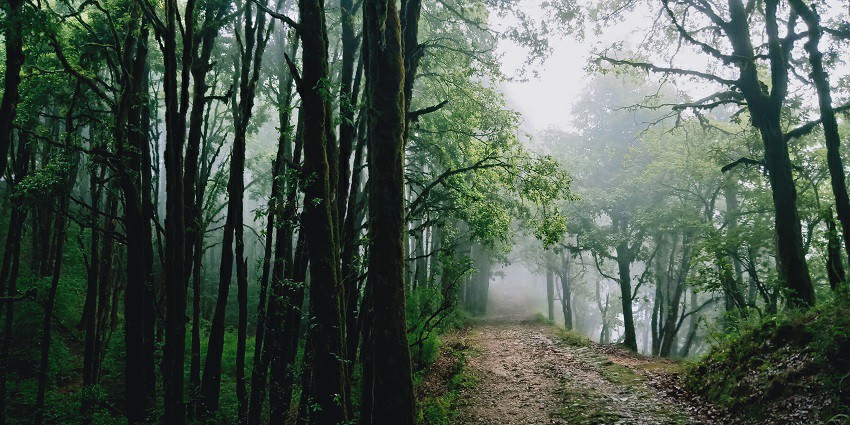
Photo: Shyamal / Wikimedia Commons
The best seasons to visit Binsar Wildlife Sanctuary are March through June and September through November. These months are perfect for outdoor pursuits like trekking, animal safaris, and birdwatching because of the mild weather and clear skies. Be ready for freezing temperatures and the possibility of snowfall if you’re going to be there in the winter (December to February).
Other Factors To Consider
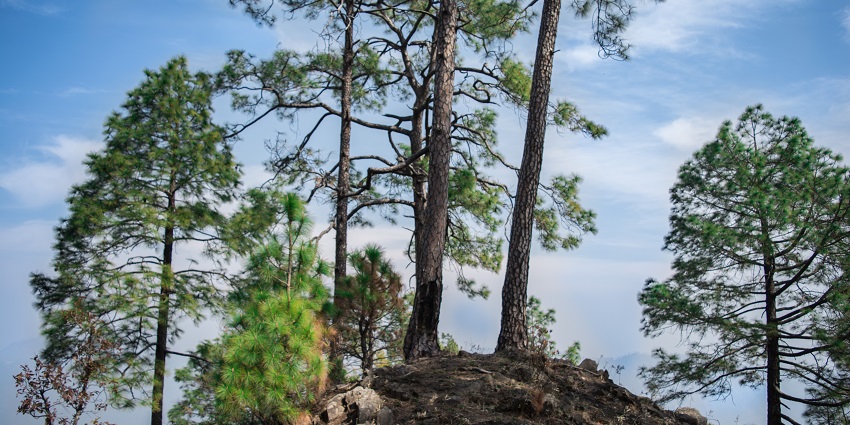
Photo: Rajborah123 / Wikimedia Commons
The following are some fascinating yet little-known facts about Binsar Wildlife Sanctuary:
- Local people employ the abundance of medicinal plants found in the woodlands for customary healing methods.
- At 2,420 meters above sea level, Binsar Wildlife Sanctuary provides stunning vistas of the Himalayas, featuring peaks like Nanda Devi, Trishul, and Kedarnath.
- There are more than 200 bird species in the sanctuary. Here, you can see some uncommon species, such as the White-tailed Nuthatch and Black-throated Sunbird.
- The sanctuary is home to the 9th-century Mahadev Temple, which is devoted to Lord Shiva.
- Zero Point, Binsar’s highest point, provides a breathtaking view of the surrounding valleys and peaks.
Tips For Visiting
- Bring Extra Cash: It’s a good idea to bring extra cash for your needs because there aren’t many ATMs in and around the sanctuary offices.
- Mobile Access: Before entering the sanctuary, let your loved ones know that there is limited mobile access. Downloading offline maps and guides is also a smart idea.
- Stay Hydrated: Drink lots of water because the high altitude might cause dehydration.
- Show Respect For Local Culture: The Kumaon region has a rich cultural history, therefore show consideration for regional traditions and customs.
- Timings: Tourists can visit Binsar Wildlife Sanctuary every day between 9 AM and 7:30 PM.
Suggested Read: Jim Corbett Jungle Safari A Wild Encounter
Binsar Wildlife Sanctuary is a heavenly home with serene surroundings, enchanted forests, and breathtaking views of the vast Himalayas. There will be plenty of opportunities for hiking, nature study, birdwatching, and seeing temples and other archaeological sites in this area. In order to witness the splendour of the hill station, the tourist can schedule his journey to Binsar during the summer holiday. Plan your journey and learn more about the Binsar Wildlife Sanctuary and its environs by subscribing to TripleXL.
Cover Photo: Rajborah123 / Wikimedia Commons


 WhatsApp
WhatsApp
 Twitter
Twitter









